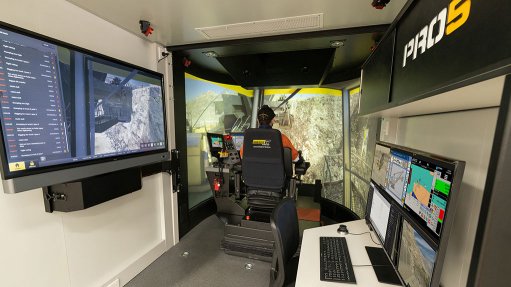AI is driving data centres to the edge
This article has been supplied by the author and has not been written or solicited by Creamer Media. It may be available only for a limited time on this website.
By Ben Selier, Vice President, Secure Power, Anglophone Africa at Schneider Electric
The data centre has become the cornerstone that links our digitally interconnected world. At the same time, the rapid growth and application of artificial intelligence (AI) and Machine Learning (ML) is shaping the design and operation of data centres.
The training requirements associated with AI are driving new chip and server technologies and the need for extreme rack power densities.
The distinction between training and inference is critical when designing AI systems. Training workloads are used to train AI models like large language models (LLMs). These workloads require massive amounts of data fed to specialised servers with processors known as accelerators.
Inference models might be deployed on edge devices or cloud servers, depending on the application's needs, and take the previously trained AI model into production to predict the output of new queries (inputs).
This demand for high-performance computing has led to increased requirements for powerful servers, GPUs (Graphics Processing Units), and other specialised hardware within data centres to support workloads.
At the same time, the rise of edge computing, where computing resources are brought closer to the location where data is generated, is driven in part by AI applications.
Edge data centres are deployed to reduce latency and enhance the performance of AI applications in scenarios where real-time processing is critical like monitoring the movements of hospital patients to keep them safe.
The servers supporting these AI applications use advanced AI chipsets, more commonly known as AI accelerators. These chipsets play a crucial role in enhancing the performance of AI applications across various domains.
Energy consumption and demand for power
Modern data centres use high-density servers and equipment that demand more power for processing. This leads to concentrated energy usage in smaller spaces, increasing the overall energy footprint, which can raise concerns about the amount of energy required to process AI operations.
For example, if your AI model is operating emergency vehicle routing, it will need to process high-definition videos and traffic patterns to perform real-time operations to clear the traffic.
This would probably be an IT network of high speed, networked edge AI data centres that could process a larger amount of data and deliver real time decisions and predictions.
As the dependence on AI continues, new technologies and techniques will be deployed to make AI faster and more accurate and efficient.
One of these techniques is moving compressed models to the edge in the form of edge AI data centres. This will enable businesses to match the application to the model and optimise performance and the energy use.
The rapid growth in data traffic
The emergence of autonomous AI agents and decision-making programs holds the potential to revolutionise various aspects of business operations. These intelligent programs perform tasks independently, adapting and learning from its environment.
With increasing AI-driven automation, data centre employees can then automate routine tasks, reduce manual workloads and enhance overall efficiency as responsibilities such as server system maintenance or system monitoring can be handled by these intelligence programs.
AI and data centre evolution
As AI technology advances, it will continue to influence the design and operation of data centres. While these advancements bring efficiency and innovation, it also poses challenges related to energy consumption, and power and cooling systems.
This relentless advancement of AI is only going to continue, and to meet these evolving needs, the data centre industry needs to adapt.
Schneider Electric offers guidance on best practices for embracing scalable and flexible infrastructure design to support intensive AI workloads. Strategies include deploying high-efficiency and high-capacity power systems and liquid cooling systems, 48U wide enclosures, upgrading hardware, and data centre infrastructure management.
Comments
Press Office
Announcements
What's On
Subscribe to improve your user experience...
Option 1 (equivalent of R125 a month):
Receive a weekly copy of Creamer Media's Engineering News & Mining Weekly magazine
(print copy for those in South Africa and e-magazine for those outside of South Africa)
Receive daily email newsletters
Access to full search results
Access archive of magazine back copies
Access to Projects in Progress
Access to ONE Research Report of your choice in PDF format
Option 2 (equivalent of R375 a month):
All benefits from Option 1
PLUS
Access to Creamer Media's Research Channel Africa for ALL Research Reports, in PDF format, on various industrial and mining sectors
including Electricity; Water; Energy Transition; Hydrogen; Roads, Rail and Ports; Coal; Gold; Platinum; Battery Metals; etc.
Already a subscriber?
Forgotten your password?
Receive weekly copy of Creamer Media's Engineering News & Mining Weekly magazine (print copy for those in South Africa and e-magazine for those outside of South Africa)
➕
Recieve daily email newsletters
➕
Access to full search results
➕
Access archive of magazine back copies
➕
Access to Projects in Progress
➕
Access to ONE Research Report of your choice in PDF format
RESEARCH CHANNEL AFRICA
R4500 (equivalent of R375 a month)
SUBSCRIBEAll benefits from Option 1
➕
Access to Creamer Media's Research Channel Africa for ALL Research Reports on various industrial and mining sectors, in PDF format, including on:
Electricity
➕
Water
➕
Energy Transition
➕
Hydrogen
➕
Roads, Rail and Ports
➕
Coal
➕
Gold
➕
Platinum
➕
Battery Metals
➕
etc.
Receive all benefits from Option 1 or Option 2 delivered to numerous people at your company
➕
Multiple User names and Passwords for simultaneous log-ins
➕
Intranet integration access to all in your organisation





















